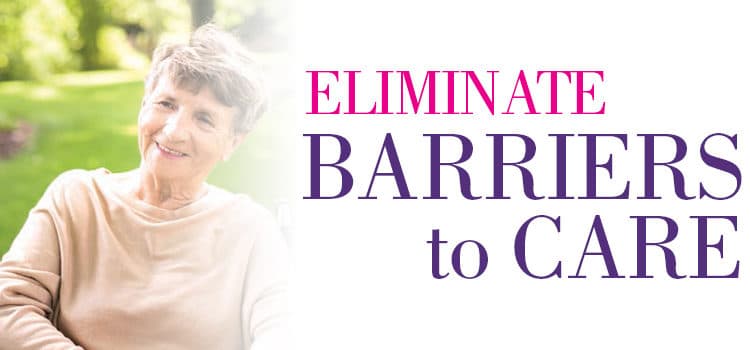 KATARZYNABIALASIEWICZ/ISTOCK/THINKSTOCK
KATARZYNABIALASIEWICZ/ISTOCK/THINKSTOCK
Eliminate Barriers to Care
Public health dental hygienists are helping to improve the access of vulnerable populations to dental services.
Many patients in the United States continue to receive dental care in the traditional private practice setting. These patient populations are typically covered by some type of dental insurance or have the necessary funds to cover these expenses. Research shows that in 2013, 49% of working-age adults with private dental insurance visited a dental practice within the past year, while only 20% of those covered by public insurance programs, such as Medicaid, had a dental appointment, and only 17% of uninsured individuals visited an oral health professional during the previous year.1 Unfortunately, the private practice model of delivery does not work for all populations, particularly those most vulnerable.
Achieving optimal oral health is difficult for individuals and families with limited resources. Barriers to care include low income, no dental insurance, lack of transportation, and the inability to take time off from work for dental appointments. The level of reimbursement for providers in public programs is generally low, inhibiting the participation of oral health professionals in such programs. Special patient populations—such as those with developmental and physical disabilities and older adults—may face additional obstacles when seeking oral health care.2
Changes to public attitudes about the importance of oral health and its relationship to overall health are critical to improving the health of all Americans. Additionally, examination of the service delivery models to identify dental professionals and protocols that will improve access to care, such as expanding the use of public health dental hygienists (PHDHs), is key to ensuring that individuals receive the dental care they need to achieve optimal oral health.2
PUBLIC HEALTH DENTAL HYGIENISTS
A PHDH is a registered dental hygienist who holds a valid license to practice and is allowed direct access to patients. Direct access means that dental hygienists are allowed to plan and initiate dental hygiene treatment without the specific permission of a dentist. Direct access settings may include schools, Head Start programs, long-term care facilities, community health centers, hospitals, medical facilities, prisons, residential treatment facilities, public health programs, and portable dental programs. In some instances, PHDHs provide care in private residences when patients are homebound.3
Currently, 39 states allow direct access, with the scope of practice varying by jurisdiction. For example, PHDHs in Massachusetts may provide the full range of dental hygiene services allowed in private practice under general supervision, but in public health settings without the supervision of a dentist. These services comprise prophylaxis, root planing, fluoride application, and placement of sealants. Massachusetts PHDHs are not allowed to administer local anesthesia because this must only be done under the direct supervision of a dentist. Further, PHDHs must hold a valid dental hygiene license to practice in the state of Massachusetts; have 3 years of full-time practice experience or 4,500 hours of part-time practice experience; and complete additional training requirements, including a minimum of 6 hours of hands-on experience in a public health setting and a minimum of 4 hours of didactic continuing education in the areas of infection control, risk management, and management of medical emergencies. They are allowed to purchase equipment and set up a public health dental hygiene practice; however, a special permit is required to own a portable dental operatory.4 In Massachusetts and many other states, PHDHs are required to maintain a collaborative agreement with a licensed dentist who agrees to provide the appropriate level of communication and consultation to ensure patient health and safety.4
State practice acts vary considerably in the scope of practice for PHDHs. Some states allow PHDHs to provide comprehensive preventive care, including administering local anesthesia, while others allow direct access only for screenings, fluoride treatments, and sealant application.2
REIMBURSEMENT
While PHDHs are allowed to directly bill Medicaid in 18 states—Arizona, California, Colorado, Connecticut, Maine, Massachusetts, Michigan, Minnesota, Missouri, Montana, Nebraska, New Mexico, Nevada, Oregon, Rhode Island, Vermont, Washington, and Wisconsin—they typically are prohibited from billing third-party private insurance.5 This raises the issue of sustainability. Anecdotally, it has been reported that some PHDHs provide 40% to 50% of their services without any reimbursement.2
CONCLUSION
PHDHs are committed oral health professionals who have embarked upon a challenging but very rewarding career path. These dental hygienists are increasing access to care by eliminating barriers one at a time. Hopefully, the impediments that limit dental hygienists’ access to patients and their provision of preventive services will eventually be eliminated, with the hopes of improving patient outcomes among the nation’s most vulnerable residents.
REFERENCES
- Hinton E, Paradise J. Access to dental care in medicaid: spotlight on nonelderly adults. Available at: kff.org/medicaid/issue-brief/access-to-dental-care-in-medicaid-spotlight-on-nonelderlyadults/. Accessed September 21, 2016.
- Pelullo KL. Sunstar spotlight: serving disadvantaged populations. Dimensions of Dental Hygiene. 2014;12(11):17–20.
- American Dental Hygienists’ Association. Direct Access States. Available at: adha.org/resourcesdocs/7513_Direct_Access_to_Care_from_DH.pdf. Accessed September 21, 2016.
- Board of Registration in Dentistry. 234 Code of Massachusetts Regulations. Available at: lawlib.state.ma.us/source/mass/cmr/cmrtext/234CMR5.pdf. Accessed September 21, 2016.
- American Dental Hygienists’ Association. Reimbursement. Available at: adha.org/reimbursement. Accessed September 21, 2016.
From Perspectives on the Midlevel Practitioner, a supplement to Dimensions of Dental Hygiene. October 2016;3(10):38-39.

